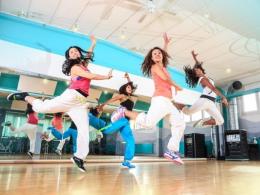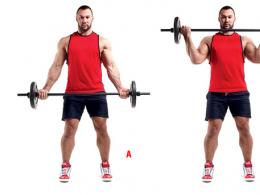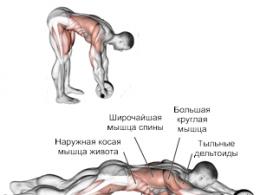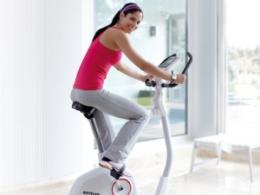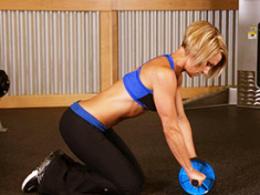Types of dance aerobics. What is dance aerobics? Structure of dance aerobics
Dance aerobics is an invention of the 70s of the last century. Today it not only does not lose popularity, but is also constantly developing, adding new trends and styles. And why not, because this is not only an effective, but also a fun way to lose weight and stay in excellent physical shape!
What is dance aerobics?
For the first time, the concept of “aerobic dancing” was used by Jackie Sorensen - she developed a program of exercises for different muscle groups, performed to music. Subsequently, the theme was picked up by the famous actress Jane Fonda, whose videos with rhythmic gymnastics complexes are still popular. From the point of view of modern dance fitness, the works of “Lady Aerobics”, as Jane was nicknamed, belong to the disco direction. And there are many such directions today.
A pleasant “side effect” of these is the formation of posture, the development of coordination of movements and the ability to move beautifully.
Dance aerobics is a set of cyclic exercises that involve at least two-thirds of the muscles. Like other types of cardio exercise, this workout:
- actively consumes energy (300-500 kcal per session);
- develops the cardiovascular and respiratory systems;
- increases endurance;
- strengthens muscles, ligaments and tendons.
Basics of dance aerobics
Any direction of dance aerobics uses the following basic elements:
- Steps;
- lunges;
- knee raises;
- swings;
- jumps;
- jumping.
They are combined into dance sequences with arm and body movements characteristic of a particular style.

As a rule, a workout contains four main blocks: warm-up, dance-aerobic part, cool-down, strength part. Next, using the example of a video lesson, you will see how you can build a dance aerobics workout:
The intensity of each workout, determined by heart rate, changes during each session - gradually increasing towards the end of the second block and gradually decreasing after reaching the maximum.
Many sets of dance aerobics exercises are of medium intensity, designed for healthy adults. For children, pregnant women, the elderly, and beginners with any health problems, low-intensity training is more suitable. High-intensity aerobics - for well-trained athletes.
Dance aerobics styles
Almost every dance style is reflected in aerobics. Today we can distinguish about a dozen styles:
- classical. The one that was invented in America in the 70s. Continuously developing, adapting to new popular melodies, adding new movements and elements, it remains on the crest of the wave of any fashion.
- Rock 'n' roll. A very dynamic type of dance aerobics, in which there are a lot of jumps, swings, and turns. Excellent effect on the entire lower body. This style does not require any special talent or choreographic training, but it is not suitable for people who are overweight or have problem joints.
- Latina. The direction is based on Latin American dances. Of course, it’s tempting to learn hot dances to fiery rhythms, and even get your figure in order at the same time. Springy steps, mobile hips, a proud head posture and graceful hands are recognizable features of a Latina. You can find programs that use a certain average Latin American style (zumba), but there are also highly specialized ones - salsa, samba, etc.
- Hip-hop aerobics. Despite the seemingly simple basic movements, this style of aerobics requires some athletic training, joint mobility and good endurance. So you can do it if you are in good physical shape, although initial dance training is not necessary.
- Funk. This is the opposite case, when it is worth starting classes only with some choreographic and even gymnastics base. The style is interesting, beautiful, requiring good flexibility of the spine.
- Body ballet. It is advisable to start mastering from a special simplified level. Suitable for people with minimal choreographic training. Forms not only a thin waist, but also strong flexible legs and excellent posture.
- Jazz aerobics. Will give you excellent posture, grace and a flexible spine. A fairly simple type of dance aerobics that does not require any initial training or special physical data. You will lose weight using this program more slowly than with more intense types of training, but the rate of weight loss does not always determine the effectiveness of the training. If you want to loosen up and move beautifully, this style is for you.
- Indian style, which is also called Bollywood aerobics. This is an energy-consuming form that perfectly develops grace, plasticity, the ability to feel your body and present it beautifully.
- East style. Combines elements of oriental belly dance with the principles of modern aerobics. Flexibility and grace, masterful control of your body, seductiveness and sexuality in every movement - this is what can be the result of long-term training in this style of aerobics.
Among such a variety of styles, Zumba is very popular among trainers. In the following video you can familiarize yourself with the main steps of this training:
To see how fun and energetic Zumba dance training is, watch the video lesson:
Dance aerobics at home
One of the advantages of dance aerobics is the absence of the need for any devices, equipment, or special clothing. You can also choose the time at your discretion (the main thing is that it is no earlier than an hour and a half after eating). Other rules can be found below:
- Training should be regular: from 2-3 times a week at the initial stage to 5-6 times in the future. As your fitness level increases, you can think about more complex routines or alternating aerobics with strength training.
- The duration of the workout should be gradually increased from 30-40 minutes to an hour, at least, since the fat burning process starts only after the glycogen reserves in the muscles are completely absorbed, and this can take from 20 to 40 minutes.
- After training, you should definitely cool down, stretch, and gradually reduce activity. You shouldn’t immediately run to the kitchen or take a horizontal position.
- A smart diet rich in protein and plant foods will help you achieve your weight loss goals faster and bring positive changes in your appearance.
Dance aerobics with explanations for beginners from a fitness trainer is presented in the following video lesson:
A 20-minute simple dance workout is also presented in the video below:
Contraindications (full or partial) for dance aerobics include:
- too much excess weight;
- diseases of the respiratory system and cardiovascular system;
- serious problems with the spine and joints;
- varicose veins of the lower extremities;
- TBI within the previous three years.
Video lesson on dance aerobics from Denise Austin
When starting to practice aerobics at home, find special video lessons designed specifically for beginners. This will make it easier for you to adapt to a new type of load. Having mastered the simplest level, you can move on to moderate-intensity classes, for example, from the wonderful Denise Austin:
In the next article we will talk about others. Do not miss.
Dance aerobics is a great way to lose weight and learn to dance in your favorite style. Regular exercise will definitely give results, and not only in the form of plumb lines or reducing volumes. You will definitely notice an increase in vitality and mood, you will become self-confident, relaxed and graceful.
For representatives of the fair half of humanity, monotonous exercise on exercise machines to get their body in order is not just difficult or impossible, but uninteresting, which is reflected in the results of the training.
Sometimes there is simply no time to go to the gym two or three times a week with an active lifestyle, which is combined with household chores and chores.
Dance aerobics for weight loss is a popular trend in the fight against excess weight, which began to develop in Russia, when no one knew about the word “fitness”.
Advantages and benefits of dance aerobics for weight loss
Intense dance aerobics for weight loss has only positive reviews. With the help of simple exercises accompanied by cheerful music, ladies and senoritas not only relax, but also, by performing simple movements and steps, train their muscles, burning extra calories.
Dance aerobics for weight loss (also called low-impact) has a huge number of advantages, including the following:
- When performing simple exercises and steps, the body's endurance is trained and the speed of metabolic processes increases.
- The level of cholesterol in the blood decreases, blood circulation significantly improves, which has a very positive effect on the cardiovascular system as a whole.
- Calories are burned.
- Lung volume increases, which has a beneficial effect on breathing.
- The skeleton is strengthened, becoming more resilient.
- Cheerful music and dance exercises help relieve stress and strengthen the nervous system.
- Coordination improves, agility and flexibility are trained.
- You can conduct dance aerobics classes in a specialized hall or at home.
When starting low-impact aerobics classes, which do not involve the use of weights, exercises with a fitball or on a mat, you can use the recommendations of leading trainers.
For example, videos with Anita Lutsenko or Denise Austin will tell you in detail about all the nuances of fun activities.
Dance aerobics with Anita Lutsenko - video:
The right exercises will help you quickly achieve the desired result.
Dance aerobics classes with Denise Austin - video:
But, like any other sport or physical exercise, dance aerobics for weight loss not recommended for in the following cases:
- If you have suffered a traumatic brain injury or spinal injury, excessive activity during certain exercises can cause an exacerbation of a particular disease.
- People who suffer from asthma attacks are contraindicated in dance aerobics.
Exercising can worsen chronic cardiovascular diseases. This is especially true for previous heart attacks.
- The stress on the leg muscles can contribute to the development of varicose veins if there is a predisposition to it. And also if this disease is present, it is not recommended to attend dance aerobics classes or do them on your own.
Classification of dance aerobics
The desire to have a slim, toned and slightly pumped up body can be easily achieved with the help of dance steps and light exercises to cheerful and lively music, which will not only help burn calories, but also lift your spirits, charging you with positive energy. Effective dance aerobics classes can be divided into several types.
Dance aerobics Jazz (Jazz aerobics)
 A feature of this type is the smoothness of movements. In addition, here attention is paid mainly to the formation and development of correct posture.
A feature of this type is the smoothness of movements. In addition, here attention is paid mainly to the formation and development of correct posture.
Dance aerobics Hip-hop (Hip-hop aerobics)
For beginners, even the first classes of this type may seem quite difficult, but the dynamism and intensity help burn up to 500 kilocalories per hour of exercise.
In addition to endurance and graceful movements, this look can allow you to show off your knowledge of hip-hop moves at parties.
Dance aerobics Funk (Funk aerobics)
- Despite the abundance of different steps and movements of this type, it will be less intense, and the classes will be less exhausting than hip-hop aerobics.
- In addition to excellent posture, regular exercise can improve your coordination.
Dance aerobics Latina (Latin aerobics)
- This is a classic look that has become the basis for many other varieties.
- The basis of this type of aerobics is the work of the hips, which not only pumps up the gluteal muscles, but also allows you to remove all the folds from the abdomen.
Dance aerobics Rock-&-roll (Rock and roll aerobics)
- Aerobics filled with jumping, sharp turns and running will appeal to active and dynamic individuals.
This sport is especially popular among restless children.
- With regular exercise, the muscles of the back, arms, abs and leg muscles are strengthened.
Dance aerobics Pump it up (Aerobics Pump-it-up)
This type of dance aerobics consists of performing various steps and exercises using a barbell.
By holding hand weights in their hands and doing pump it up, people not only burn calories faster, but also pump up their arm muscles.
Dance aerobics Zumba
Zumba is not just a type of dance aerobics, but also an almost independent fitness program, which is based on performing rhythmic movements to Latin music: salsa, rumba, mamba, cumbia and others.
This is the best dance aerobics for weight loss. Basically, Zumba requires group participation rather than solo performance.
Regardless of which type is preferred, the main thing is the amazing positive results with regular training.
Zumba dancing for weight loss - video:
At home or in the gym, on your own with a training video or with a professional trainer - this is not so important.
Note that for any dance aerobics classes you only need desire, a little free time and the desire for good results.
Dance aerobics training lessons for beginners
The name “dance aerobics” already speaks for itself. When making a choice - independent training at home or in the gym, you should, first of all, rely on the main goal.
If the desire to lose excess weight led you to dance steps, then you can do them at home.
A set of dance aerobics exercises for weight loss
If you want to learn new skills, improve coordination and improve your body by pumping up your muscles, you can start right away with dance movements. 
Basically, training lessons for beginners consist of several sections. Each lesson will consist of a warm-up, main part and conclusion, which will allow you to correctly calculate your energy and strength. So let's get started.
Lesson 1. Warm up
The first lesson will begin with a short warm-up, which will help you warm up and get ready for the lesson.
The duration of the warm-up usually does not exceed five minutes.
While monitoring your breathing during warm-up, perform the following “light” movements to the music:
- They actively move their arms, you can swing them up and down, rotating your hands and shoulders.
- Turning the body, bend and twist, making less active movements.
- Knead the muscles of the back and neck. To do this, they make soft turns of the head to the music, and also try to depict a “wave”, as in oriental dances.
- Afterwards, you should warm up the muscles and joints of your legs. To do this, you can do several swings, lunges, or simply transfer your weight from one leg to the other.
Lesson 2. Main part
After warming up, you can safely move on to the main exercises, adding intensity and activity to the execution. Here everything depends on the desired result and the chosen type of dance aerobics.
- For example, to lose belly fat, while doing the main part, you spend a lot of time on exercises that help strengthen your abdominal muscles.
- To lose weight in your legs, it is important to use movements that will strengthen the muscles of your thighs and lower legs and tighten your buttocks.
- When practicing independently at home, do not forget that this is dance aerobics, which should be enjoyable. Try to remember and perform some kind of dance movement, move actively, you can even jump to the beat of the music.
When practicing on their own, many first accurately repeat the exercises and movements that are recommended in videos, or seen somewhere before. But already from about the third lesson there is a desire to improvise, inventing your own exercises.
- Dance aerobics can be called cyclic exercises that simultaneously engage many muscle groups.
- The training uses elements such as steps, swings, lunges, running, jumping, knee raises and jumps, depending on the desired result.
- Also, depending on the chosen music to accompany the activity, you can perform movements with different intensities. For example, with more gentle music the movements will be smooth, but with rhythmic music they will become sharp.
Lesson 3. Final part
At the final stage of your workout, you should do some stretching, which will not only restore your muscles and slow down the momentum, but will also help you acquire beautiful shapes.
Part 4, dancing for weight loss, final part - video:
Victoria Artemyeva
Dance aerobics, or stretching, is a program consisting of specially designed movements that are performed to music. Performing such rhythmic exercises is aimed at losing weight, improving health, developing and strengthening muscles, and creating a beautiful figure.
This is one of the modern trends in fitness, which is not only the most effective, but also very interesting. The basis of the dance programs consists of several musical styles, such as hip-hop, Latin, funk, modern jazz and some others. Each of these areas of dance aerobics is characterized by its own music and movements.
What are the benefits of dance aerobics?
The effectiveness and benefits of dance aerobics are so obvious that they do not require proof. People involved in this type of fitness note that they not only lose weight by dancing dance aerobics, but also feel an improvement in their well-being.
By regularly attending classes, you can achieve the following goals:
- reduce weight;
- strengthen muscles;
- improve posture;
- make your figure more attractive;
- normalize the cardiovascular system.
Moreover, specific movements help develop plasticity and flexibility. This type of aerobics has no age restrictions; both children and adults can dance if desired. Such exercises under the supervision of a trainer are useful even for pregnant women.

It is important to know that dance aerobics for beginners should only be done together with a trainer, thereby eliminating the possibility of injury.
Aerobics protects a person from stressful situations because it gives him a powerful charge of positive energy. The desired changes can be achieved only if you complete classes lasting 2 hours three times a week.
Dance aerobics styles
When attending dance aerobics classes, everyone can choose the direction they like. There are many types of stretching, depending on the goals set, as well as the movements performed.
Among its areas you can choose the following types of dance aerobics:

- Bellydance. It became popular not so long ago, however, it is a favorite pastime of many girls and women. Belly dancing is an Arabic belly dance that is considered the most feminine and charming style. With the help of rhythmic movements, you can get rid of fat deposits in the waist and hips, tighten your abdominal muscles and significantly improve your posture. For beginners who are involved in fitness, no preparation is required, which is the advantage of the direction, but you should know that it will be possible to lose weight no earlier than after 3 months of intense training;
- Strip dance. People aged 25 to 40 years prefer this type of fitness. Each lesson must begin with a warm-up and strength training. The main focus of strip dancing is stretching, which is given special attention during classes;
- Jazz aerobics. The main goal of this type of dance aerobics is to eliminate poor posture. Classes consist of a warm-up, ground floor, main and final parts, and last on average 60 minutes;
- Funk. This direction of stretching involves performing movements at a consistent and continuous pace of moderate intensity. The main load falls on the spine, since during exercise it is necessary to perform certain body movements. People who already have good choreographic training will be able to do funk aerobics;
- Hip-hop . Hip-hop dance aerobics is suitable for hardy people, since this direction is considered one of the most difficult types of modern stretching. Dancing hip-hop, you can burn approximately 450 kilocalories in one session;
- Latina. Latin dance aerobics classes are characterized by intense hip movements, a fixed back position and a springy step. This direction is not characterized by a power load, however, the trainer can complicate the combination with jumps.
Such a wide variety of dance styles makes it possible for almost anyone to choose the music to which they best dance. During training, as well as in order to build the correct choreography, it is important to be able to select music.
Dance aerobics is one of the areas of fitness, which is a set of exercises performed to the accompaniment of music. It is otherwise called “low-impact aerobics”, since these physical activities do not involve performing exercises while lying on a mat or using special equipment and devices.
Dance aerobics attracts many people with its accessibility, creativity and emotionality.
The difference between dance aerobics and dancing itself is that during training the movements are almost continuous - whereas in dance lessons you have to pause to learn new movements. Dance aerobics “kills two birds with one stone”: it burns calories, promoting the overall health of the body, and teaches the athlete the art of dancing - albeit not at a professional level, but at a quite decent level.
Dance aerobics classes allow you to keep your body in excellent physical shape, stimulate muscle flexibility, and promote fat burning. In addition, dance aerobics, unlike gymnastics and athletics, is an excellent antidepressant that allows you to develop in a person not only flexibility, plasticity and grace, but also a “creative streak”, changing the content of the course depending on your preferences, physical capabilities and interests .
Regular dance aerobics lessons allow you not only to build the correct body proportions, but also to make your body healthier and more resilient.
The term “aerobic” literally means “using oxygen” or “living on air.” Research by world health institutes (including specialists from Reebok University) has confirmed the positive effect of dance aerobics on the functioning of the respiratory and cardiovascular systems. Aerobic exercises force the heart, blood vessels and lungs to “work” in a certain mode and adapt to increasing loads. As a result, a powerful immune system is created, the body is filled with capacity for work and energy, and a person forgets what “chronic fatigue” is.
Below are some of the positive effects of regular dance aerobics:
- An increase in blood volume in an amount that increases the ability to transport oxygen to the tissues of the body;
- Strengthening the heart muscle, improving its blood supply;
- Strengthening the skeletal system, musculoskeletal system;
- Increased performance;
- Increased lung volume;
- Reducing blood cholesterol levels;
- Increased stress resistance.
Dance aerobics is perfect for weight loss: exercise helps burn calories faster, strengthens muscles and shapes your figure. In order for aerobics to lead to the long-awaited result, namely, a slim and flexible body without excess weight, you must adhere to several rules:
- Classes should be regular (at least 2-3 times a week);
- It is necessary to start exercises no earlier than 1.5 hours after eating;
- After dance aerobics lessons, you should not immediately have lunch or lie down on the sofa: intense fat burning occurs for several hours after the exercises;
- Despite the presence of physical activity, it is recommended to follow the principles of rational nutrition, avoiding excesses.
Dance aerobics at home
In order to feel the effect of exercise, it is not necessary to use the services of a specialist or visit a sports center - you can do dance aerobics at home. Let's learn a few principles, without which not a single dance aerobics lesson is complete:
- Warm up. In order for the body to adequately absorb the load, it must be prepared by performing exercises for the arms, shoulder girdle, torso, legs and neck. Of course, to any rhythmic music;
- Aerobic phase. It is the basis for achieving the healing effect of exercise. It is characterized by moderate loads that increase the rate of breathing and heart rate, but do not disturb the balance between inhalation and exhalation. The optimal heart rate in the aerobic phase is 140-160 beats per minute. You can check the intensity of aerobic exercise using the “talking test”: if you can carry on a conversation during an exercise, then the load is acceptable;
- Power phase. Strength exercises should be no more than 10 minutes from a dance aerobics class. They include squats, push-ups, jumping and some other types of loads. During the strength phase, bones and joints are strengthened, as well as excess calories are quickly burned;
- Preparing for graduation. Stopping exercise suddenly is not recommended: it is dangerous due to a sharp drop in blood pressure. After completing classes, you cannot stop or sit down: you need to walk around the room for a while, stretch your muscles, measure your pulse and wait until your heart rate returns to normal.

Types of dance aerobics
Dance aerobics, as mentioned above, is carried out at a fast pace to one or another music. Depending on the style of music, the following types of dance aerobics are distinguished:
- Latin aerobics. One of the most popular trends in dance aerobics, the main difference of which is a springy step and continuous work of the hips;
- Funk aerobics. It involves making wave-like movements of the body and free plasticity of the arms. Recommended for people with choreographic training;
- Hip-hop aerobics. One of the most difficult types of dance aerobics. About 450 kcal are burned in one session;
- Rock and roll aerobics. The basis of this direction of aerobics is the “rock and roll” step, jumping, turning, running, moving;
- Belly dance (belly dance). It will allow you to forget about problems in the waist, abdomen and hips, make the girl more flexible and flexible;
- Strip dance. In addition to the fight against extra pounds, this trend in dance aerobics allows women to relax, feel more confident and sexy.
Contraindications
Dance aerobics is a set of exercises that are performed to musical accompaniment. This area of fitness is not only one of the most effective, but also very, very interesting.
At its core, dance aerobics is a type of so-called “low-impact aerobics” of medium intensity. It does not imply that special equipment will be used when performing the exercises. In addition, in dance aerobics there are no exercises performed on a mat in a lying position.
When it comes to burning calories, dance aerobics is very effective. Its main principle is to perform combinations of all kinds of dance movements non-stop. Experts note that high-impact aerobics is a kind of physical exercise that is continuously performed to music, and dance aerobics, in turn, is an active and continuous dance of 4-8 counts.
Get rid of excess weight, make your muscles stronger (especially the muscles of the lower body - buttocks and legs, abdominals), improve posture and coordination of movements, normalize the functioning of the cardiovascular system - dance aerobics can do all this. In addition, specific dance movements help develop plasticity. Depending on what level of preparedness you have, you can choose a lesson that best suits you: for a beginner level of training, for those improving or for professionals. This type of aerobics has no age restrictions: it is suitable for both children and elderly people. There are also sets of exercises for pregnant women.
The best option for those who want to lose excess weight is to combine aerobic training with exercise in the gym. If you just want to keep yourself in good physical shape, exercising one to three times a week is enough.
Types of dance aerobics
There are many types of dance aerobics. Fast-paced workouts are carried out to the accompaniment of music that corresponds to a particular style of dance: funk aerobics, city jam, Latin aerobics, hip-hop aerobics, Afro-jazz aerobics and many others.Jazz aerobics- this direction of dance aerobics is designed to save you from postural deficiencies. The duration of the lesson is one hour. The workout itself consists of a warm-up and three parts - ground, main and final.
Funk aerobics is the continuous and consistent execution of dance exercises. The degree of intensity is moderate. Free plastic movements of the arms and wave-like movements of the body are assumed, as a result of which a large load will be placed on the spine. It is also worth noting that attending Funk aerobics classes is more suitable for people who have some choreographic training.
Hip-hop aerobics- This is a complex type of aerobics; to attend such classes you need to have a certain stamina. In one workout, you can burn 450 calories.
Rock-n-Roll aerobics- At the heart of this type of aerobics is a rock and roll step. The main movements used are moving, jumping, turning, running. The structure of the lesson is as follows: first there is a warm-up, then comes the main part, and after that the final part.
Latina aerobics is one of the most popular areas in aerobics. The main feature is a springy step and continuous work of the hips, while the back should be in a fixed position. The structure of the training does not involve a strength part, but to increase the load, at the initiative of the trainer, the combination of exercises can be complicated by jumping. When performing dance movements, you need to keep your body rigidly fixed and your abs tense, while you need to actively work with your hips.
This variety is good because it makes it possible to choose the kind of music that will work best for you, since the choice is practically unlimited. First of all, you need to decide on your desires and goals. After this, a training program is selected together with the trainer. The biggest advantage of dance aerobics is that you can do it at home at any time convenient for you, having previously developed a complex and chosen music.
Dance aerobics has its own principles of movement:
Isolation is a movement that is carried out by one part of the body at one joint while the other remains stationary;
Polycentric - movements that initially come from different centers and are carried out in such a way that different parts of the body work autonomously from each other, while their speed and amplitude are often the same;
Animation is one movement, which in one rhythmic unit is decomposed into many components;
Opposition - a movement that deliberately breaks a straight line so that one part of the body is opposed to another;
Countermovement (opposition option) - when one part of the body moves towards another.
Contraindications
You can achieve truly noticeable results when doing dance aerobics if you practice for at least one and a half or two hours three times a week. This will be quite a significant load. Before you start training, you should consult your doctor.Dance aerobics classes are contraindicated for those who have suffered a traumatic brain injury or heart attack. If you suffer from asthma attacks, you should also not attend such workouts. In addition, those who have problems with the cardiovascular system or spine should postpone training.
By using different aerobic programs, you can get maximum benefits in minimal time.

